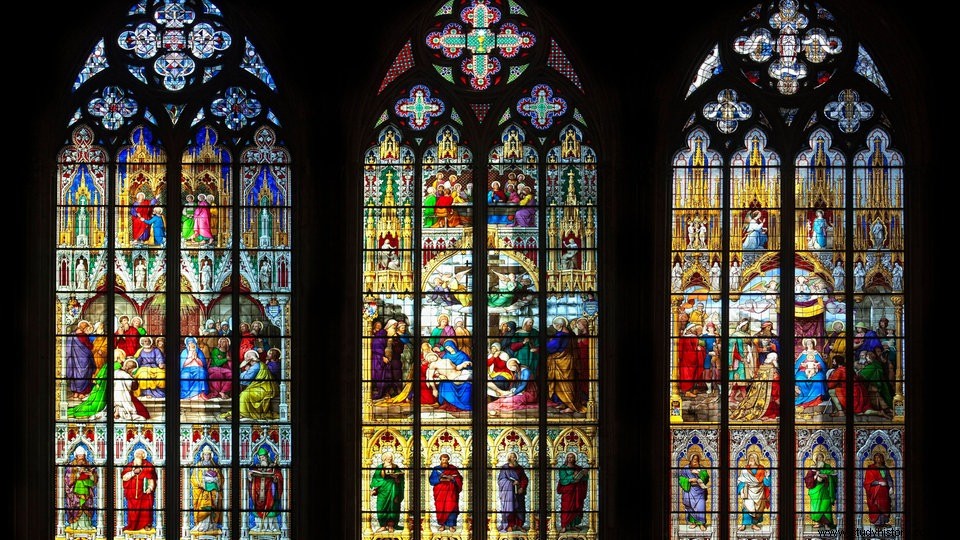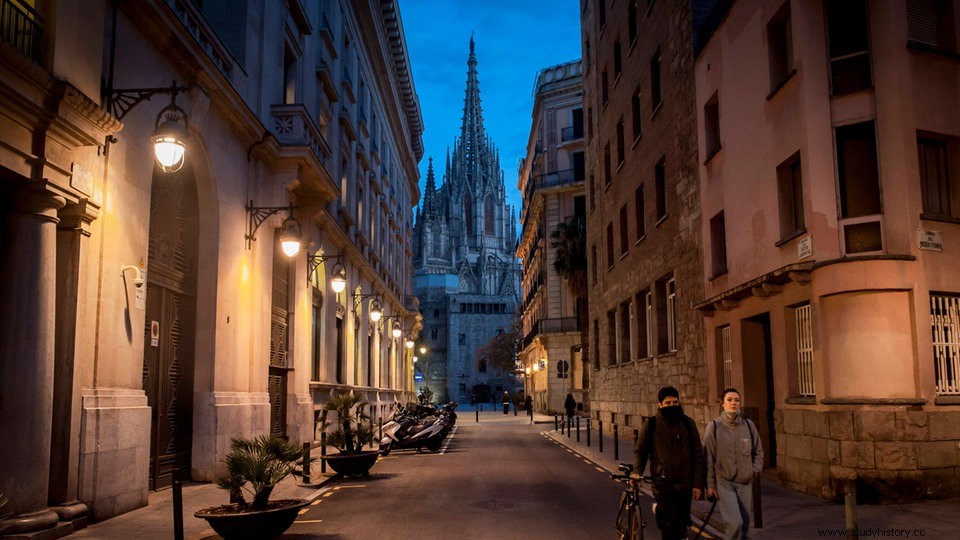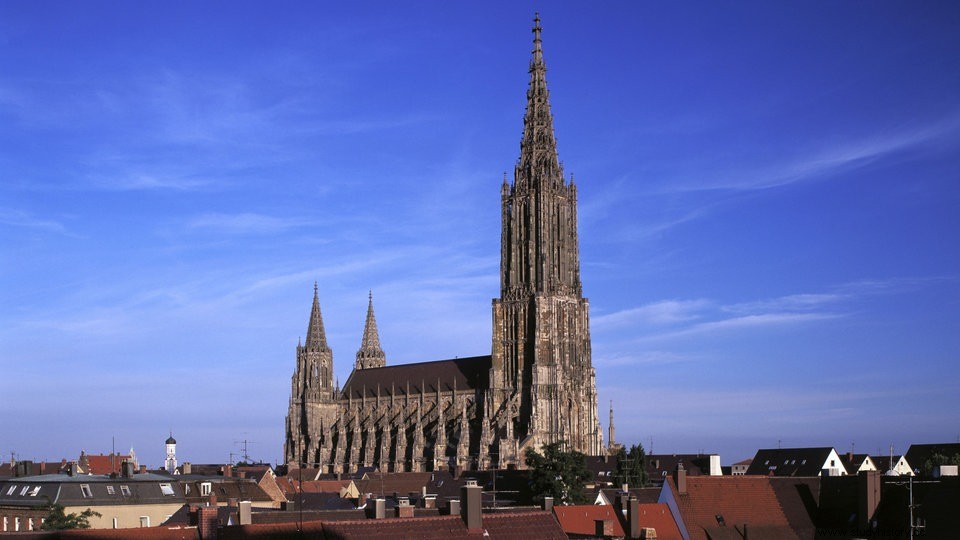"God said:Let there be light. And there was light." What sounds so easy in the biblical story of creation presented the master builders of the Gothic with immense challenges.
Colored windows instead of solid walls
While the Romanesque churches with their thick walls and small windows only let in a little light, the Gothic churches are almost flooded with light.
The master builders achieved this effect by largely dispensing with solid walls and replacing them with pillars and arches. And so Romanesque and Gothic churches also differ greatly from the outside:While the former usually appear quite massive, the latter appear almost filigree.
A lot of glass, little stone - that is one of the stylistic characteristics of the Gothic. In most Gothic houses of worship, the windows are the defining element of the room. Taken together, their area can cover several thousand square meters, so that the surrounding masonry is optically pushed into the background.
This impression is reinforced by the fact that the windows are often made of artistically painted stained glass and thus shine in many different colours.

The magnificent windows of the Gothic cathedrals tell religious stories
Aesthetics and statics
To put it simply, Gothic churches consist of a stone frame with glass walls. The glass walls are mainly used for aesthetics, the stone frame is decisive for the statics.
The pillars are part of this structure. They are connected by pointed arches and carry the vault. Because the columns alone cannot support the weight of the vault, it is additionally supported by pillars. These buttresses are external to the main building and are connected to it by flying buttresses. The lightness of the construction caused by the struts allows not only large windows, but also high rooms.
Even if the ceiling heights in Gothic churches are impressive at over 40 meters in some cases, their true size is only revealed when you look at them from the outside. Especially for the contemporaries of the Gothic epoch, these churches seemed almost sky-storming. Surrounded by low buildings, such a church always defined the silhouette of the city and usually became its symbol.
The main facade has the most powerful effect, usually flanked by two huge towers of up to 150 meters in height. These gigantic dimensions are often emphasized by the fact that the facades of Gothic churches are decorated with hundreds or even thousands of statues - carved from stone and sometimes life-size.

The height of Cologne Cathedral is still impressive today
From the Orient to the Occident
In order to be able to build in this way, a great deal of knowledge is required - especially in the areas of mathematics and physics.
The crusaders brought much of this knowledge from the Orient to the Occident. Because despite the armed conflicts, there was also a cultural exchange between Christians and Muslims. The Europeans in particular benefited from this, because the sciences in many areas in the Middle East were highly developed at the time.
The Gothic era began around 40 years after the first crusade and lasted around 400 years – from the 12th to the 16th century. It is divided into early, high and late Gothic.
Gothic began in France and then spread to different regions of Europe, each with different stylistic developments.
Although the Gothic style is also reflected in sculpture and painting, it found its most significant expression in architecture and especially in sacred buildings - churches and cathedrals.

Cologne Cathedral was only completed in the 19th century
A European Epoch
The founding building of the Gothic style is the abbey church in Saint-Denis north of Paris. The foundation stone was laid around 1130. The west facade in particular is considered to be style-defining. At that time, many French master builders took the church of Saint-Denis as a model. But the new architectural style was soon adopted in other European countries.
In England, for example, construction of Canterbury Cathedral began in 1175. At first they followed the French pattern very closely, but after a few years a specifically English variant of the Gothic style developed, which was already expressed in Canterbury Cathedral and which developed further in the course of subsequent church buildings.
Spanish Gothic was influenced by Moorish elements, as the Moors ruled parts of the Iberian Peninsula well into the 15th century. One of the most important works of Spanish Gothic is the Barcelona Cathedral, which was built from 1298.

The old cathedral of Barcelona is one of the most important buildings of Spanish Gothic
Magdeburg Cathedral – the first Gothic church in Germany
Gothic was only able to establish itself in Italy slowly, and then only for a relatively short time. One of the earliest examples of the new style is the Basilica of San Francesco in Assisi, built from 1228.
But as early as the 14th century - in the other regions of Europe the Gothic style was still developing - the first stylistic features of the following epoch were emerging in Italy:the Renaissance.
Gothic in Germany began with the construction of the Magdeburg Cathedral in 1209. However, this church also has Romanesque elements in addition to the Gothic ones, so it is a mixed form.
Only the Liebfrauenkirche in Trier and the Elisabethkirche in Magdeburg, both built around 1235, are designed in a purely Gothic style. The German Gothic came to its highest perfection - in the literal sense - at the Ulm Minster:At 161.53 meters, it has the highest church tower in the world.

The Ulm Minster still has the tallest church tower in the world
Eternal construction site and heritage of mankind
The Cologne Cathedral is considered to be the most important of all Gothic cathedrals in Germany. And this despite the fact that the Gothic era was more than three centuries past when it was completed:the foundation stone was laid in 1248 and the inauguration was in 1880.
In the more than 600 years in between, however, there was no construction at all for around 300 years, and the unfinished cathedral degenerated into a ruin. Half of the cathedral shaped the silhouette of the city and the crane on the south tower became the symbol of Cologne. This eternal construction site can be seen in many contemporary pictures.
It is not known why the construction work was stopped in the middle of the 16th century. Perhaps because the Gothic era was ending at that time or simply because the money was running out.
When construction work started again in 1842, everything happened very quickly – the cathedral was completed just 38 years later. It was built according to the original plans from the 13th century. The only deviation from these plans was the iron roof structure.
And perhaps it was this deviation that allowed Cologne Cathedral to survive the Second World War. Although the church was hit by 14 heavy aerial bombs, it did not collapse.
In order to rule out such attacks in the future, the Cologne Cathedral was officially placed under the protection of the international community in 1996. Unesco declared it a World Heritage Site as a "masterpiece of Gothic architecture".
